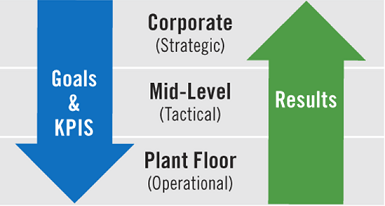7/27/2018
BY: MIGUEL GOMEZ
 What is the vision that drives your company? Why do you operate each day? What do you hope to achieve? Do your employees have the same goals? Many organizations find that their larger company visions can be forgotten in day-to-day firefighting. This is detrimental to success as workers at every level are left unaware of what they should be doing or how their work contributes to larger business goals. How can your company make sure your corporate vision is clearly understood and followed throughout the entire organization? The answer lies in policy deployment.
What is the vision that drives your company? Why do you operate each day? What do you hope to achieve? Do your employees have the same goals? Many organizations find that their larger company visions can be forgotten in day-to-day firefighting. This is detrimental to success as workers at every level are left unaware of what they should be doing or how their work contributes to larger business goals. How can your company make sure your corporate vision is clearly understood and followed throughout the entire organization? The answer lies in policy deployment.
A description of what an organization would like to achieve in the short or long-term is often referred to as the vision. This serves as a clear guide for deciding current and future courses of action. Most companies establish the vision as the starting point for all strategic planning, risk identification and tactical deployment to ensure that major initiatives align with larger goals.
In order to successfully establish and achieve a vision, companies must create an organizational structure capable of turning a vision into action through policy deployment. With effective policy deployment in place, the vision is used to inform goals and initiatives at all levels of the organization. The company vision drives the business plan, and high-level strategic plans are converted into tactical actions or projects, which organize everyone in the organization to pull in the same direction.
Various methods have been developed to ensure that the strategic goals of a company drive progress and actions throughout the organization. One of these methods is Hoshin Kanri. Hoshin, a Japanese term meaning “self-protection,” and Kanri, meaning “management,” together translate to “policy deployment.” This method of policy deployment requires a strong strategic vision to succeed. This is accomplished by keeping strategies, organizational capabilities, resources and management systems arranged in a manner that support the company’s goals through a vision understood and lived by the entire organization. The main objective of this method is to get every individual in the organization to become aligned with the vision and achieve set strategic goals by following steps outlined in the tactical plan (see figure below).

How can this realistically be achieved at your company? Follow these three steps:
- Create a strategic plan. As seen in the figure above, policy deployment starts at the top. Management is in charge of setting a company vision and strategic plan that focus on a few critical issues that need company-wide support and alignment. An important component of this step is to identify and track relevant metrics to monitor progress of goals. Otherwise, goals are meaningless.
- Develop tactics. With the vision and strategic plan established, they must then be transformed into tactical actions to outline how goals will actively be achieved. This will identify specific tasks to be accomplished at each level of the organization, effectively establishing how all departments and workers will contribute to achieving the company vision.
- Check and balance. Regular reviews of the plan and its success are critical to ensure ongoing, company-wide support. Constantly monitor progress throughout your organization to identify areas of misalignment and keep employees on track with realizing the company vision.
What Does a Cascading Vision Look Like in Practice?
A solid vision statement acts as a guide for employee actions and decision-making in all departments. For example, if your organization is working towards achieving higher customer satisfaction, this goal will cascade to every level of the organization. The quality department might then focus on decreasing defects and maintaining more quality products, while those in distribution work to ensure all products are delivered on time, with each serving the larger company goal of improving customer satisfaction.
In terms of daily performance, if a worker is deciding which project to undertake next, or how to best perform a task, they should ask themselves, “Am I being consistent with the organization’s vision statement?” If the answer is no, now is the time to pause, evaluate and, if need be, align the action or decision with the vision statement. The vision provides the guidance employees need to make the right decisions, regardless of department or project type.
Find Success with Your Policy Deployment
Achieving this company-wide alignment is not always easy, however. Many factors can hold a company back from realizing their vision, including:
- Top management is not aware of misalignment among its workforce
- Nobody in the organization has ownership of the responsibility for alignment
- Organizational model is too complex for alignment
Successful organizations learn to identify and mitigate the negative forces being exerted on their alignment efforts. For example, a flattened management structure is beneficial to Hoshin Kanri. The fewer levels there are the easier it is to cascade goals down, and the fewer opportunities there are for strategy to be muddled through successive layers of translation. Fewer layers also means faster decision-making.
People perform best when they have a purpose; when they understand not just what to do, but why it’s important. One of the advantages of Hoshin Kanri is that it can help to create that purpose, providing focus and drive towards specific, company-wide goals.
Your business will benefit from you putting the effort into creating a shared vision, strategic plan and associated tactics. By keeping employees aware of their role in achieving the company vision, they will gain a deeper understanding of why their work is important and how their tasks support larger company goals. With these elements in place, your company will be on the right path to realizing its vision.
To learn more about how to keep your business on track for success, come to The Center's upcoming free Explore event where I will discuss how to apply "core tools," such as APQP, PPAP, FMEA, MSA & SPC, to your organization to support your continuous improvement initiatives.
MEET OUR EXPERT
 Miguel Gomez, Quality Program Manager
Miguel Gomez, Quality Program Manager
Miguel is a Quality Program Manager at The Center. In his role, Miguel manages and delivers training and implementation assistance for Quality and Environmental Management Systems. Miguel comes from a strong technical background in Quality operations management, utilizing his experience in the industry to assist companies with implementing management systems including ISO 9001:2015, IATF 16949, ISO 14001 and Core Tools.
Since 1991, the Michigan Manufacturing Technology Center has assisted Michigan’s small and medium-sized businesses to successfully compete and grow. Through personalized services designed to meet the needs of clients, we develop more effective business leaders, drive product and process innovation, promote company-wide operational excellence and foster creative strategies for business growth and greater profitability. Find us at www.the-center.org.
Categories: Continuous Improvement,
Quality Management